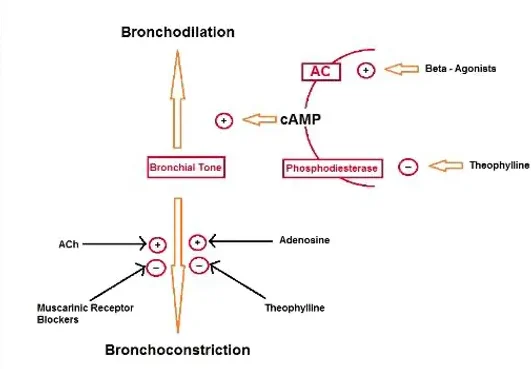F11ii / 23B11: Describe the mechanism of action, dose and pharmacokinetics and pharmacodynamics of aminophylline
23B11: Exam Report
Describe the mechanism of action, dose and pharmacokinetics and pharmacodynamics of aminophylline
21% of candidates passed this question.
This question required a detailed description of the many mechanisms of action of aminophylline. This included PDE inhibition and the down stream pathway and its adenosine antagonist and anti- inflammatory actions.
Important pharmacokinetic concepts included hepatic metabolism with saturable kinetics and thus a narrow therapeutic window/index requiring need for drug monitoring and the risk of metabolic interactions with accelerated or reduced metabolism from inducers or inhibitors of the main enzyme (CYP1A2).
Detailed pharacodynamic consequences on the respiratory and cardiovascular systems were prioritised as well as highlighting the neurological, cardiovascular and musculoskeletal consequences of toxicity.
F1ii / 23B11: Describe the mechanism of action, dose and pharmacokinetics and pharmacodynamics of aminophylline
Theophylline Aminophylline
Theophylline Aminophylline
Chemical
A methylxanthine derivative
Use
Tx bronchoconstriction
Presentation
Tablet, syrup, solution for IV injection
Route/Dose
Loading Dose 7mg/kg calculated by IB and given over 30 minutes
Maintenance 0.6mg/kg/hr (IV) or 7mg/kg (PO)
MoA
PHOSPHODIESTERASE INHIBITOR
- ∴↑cAMP
- ↑Protein kinase A
- Inhibits phosphorylation of myosin + ↓Ca2+ = smooth m. relaxation + bronchodilation
ADENOSINE RECEPTOR BLOCKER
- Blocks adenosine mediated bronchoconstriction

PD
Resp
- Bronchodilation
- ↑respiratory centre sensitivity to CO2
- Disturbs HPVC
CVS
- +ve chonotropy & inotropy
- *** arrhythmogenic at high doses
GU
- ↓RBF & GFR
- ↓Na+ reabsorption → diuresis
PK
A
- Rapidly + completely absorbed PO route
D
- 0.3 – 0.7L/kg, PPB 40%
M
- 90% of the dose is metabolised in the liver
- Hepatic Demethylation occurs and then further hydroxylation to metabolites
- Caffeine & 3-methylxanthine are the only active metabolites
- Both these pathways are capacity-limited and there is wide intersubject variability in the rate of metabolism
- The relationship is non linear and any increase/decrease in dose should be monitored with levels
- Clearance is reduced in patients with hepatic impairment
E
- Renally excreted
- 10% unchanged
- t ½ 8hrs
Therapeutic Index & Drug Monitoring
Bronchodilation occurs over a concentration of 5-20mcg/ml
As concentrations >20mcg/ml so do the frequency & severity of adverse events
Adverse Effects
Metabolic
- Hypokalaemia 2° diuresis
- Abnormal LFTs
- Inappropriate ADH secretion
CNS
- Convulsions → if administered rapidly
CVS
- Arrhythmias → including VF at high doses
MSK
- Antagonises non-depol NMB @ high doses
P50 interactions
↑[Theophylline]
- Cimetidine
- Propanolol
- Erythromycin
↓[Theophylline]
- Barbiturates
- Alcohol
- Phenytoin
Author: Krisoula Zahariou